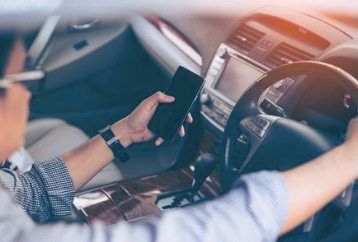
Distracted Uber Driving: Why You Could Be In Danger
Posted on February 10, 2020 in Firm News
You may not be as safe in an Uber as you thought. The Uber app could be leading to an uptick in distracted driving accidents, putting riders and other New Yorkers sharing the road at risk for life-threatening injuries.
Hidden Dangers of The Uber App
There are over 900,000 active Uber drivers in the United States battling for rides on any given day. The New York Times reports at least 65,000 of these drivers operate in New York City, completing a combined average of about 400,000 rides and deliveries a day.
Uber is the leading ridesharing service in the country. This user-friendly app helps to instantly connect riders with an alternative to yellow cabs, public transportation, or personal vehicles. Riders in need of a ride search for available drivers in the area and send a ‘driver alert’ to request a trip. The Uber driver who receives the alert accepts the job, looks up the coordinates, and provides an estimated time for arrival, or E.T.A. Once the ride is complete, the Uber driver is free to accept additional jobs.
Uber has become one of the most convenient methods of commuting in NYC, but this convenience may be coming at a cost. Certain expectations of the Uber service require drivers to check the mobile app for information constantly. Unfortunately, this means drivers are heavily reliant on using their phones behind the wheel, a behavior that is proven to lead to life-threatening accidents.
Driving Distractions Are Deadly
Everything an Uber driver needs in order to do their job is on the mobile app: ride alerts, coordinates, directions, payments, and reviews. Drivers are expected to respond within 15-seconds of a “driver alert” to maintain a positive status or risk losing future ride requests and fares. However, Uber drivers who are constantly looking at the app are focused on their phone, not the road.
Distracted driving accidents involving cell phones are a major threat to public safety. According to the National Safety Council, an estimated 1.6 million accidents are caused each year by drivers using cell phones behind the wheel. Sadly, statistics show an average of nine people die in the U.S. a day from cell phone-related crashes, and every year another 390,000 injuries have been linked to drivers who text and drive.
Distractions on the road can lead drivers to display aggressive driving behaviors known for leading to serious and fatal traffic accidents, including:
- speeding
- swerving
- failure to stop
- failure to yield
- hard accelerations
- hard stops
- neglecting to use turn signals
According to the National Highway Traffic Safety Administration, speeding is the deadliest aggressive driving behavior of all, and extremely common among distracted drivers. Speeding was responsible for taking over 3,800 lives in 2018 and is a behavior known for increasing the severity of other injuries sustained in a crash.
Types of Distracted Driving
The Center for Disease Control and Prevention (C.D.C.) illustrates three categories of distractions that can lead to fatal road accidents. These include:
- Visual: taking your eyes off the road;
- Manual: taking your hands off the wheel; and
- Cognitive: taking your mind off of driving.
The presence of one distraction can divert a driver’s attention away from the road long enough to cause a life-threatening accident. Shockingly, the Uber app allows for all three types of distractions to affect drivers at the same time. For example:
- Visual: An Uber driver takes there eyes away from the road when they look at their phone to respond to a driver alert, to check a rider’s location, or to provide an E.T.A. for arrival.
- Manual: Most drivers are not equipped with hands-free technology that allows them to control every function of their phone with their voice. Therefore, they need to take their hands off the wheel to navigate the app.
- Cognitive: Drivers who are determining an E.T.A. or deciding whether or not to accept a ride are not concentrated on the road.
The process of receiving driver alerts, accepting rides, providing E.T.A.s, and mapping out routes occurs with every ride an Uber driver accepts. Some drivers in NYC operate their ride sharing business up to 50 hours a week. This leaves a lot of opportunities for distracted driving accidents to occur.
NYC Street Dangers
The congested streets of NYC create an even more dangerous landscape for Uber drivers to operate. Drivers are faced with the daily challenge of swerving in and out of cars, trucks, buses, bicycles, and pedestrians to get to a rider or destination. This task is hard enough when a driver is fully alert. But when an Uber driver is glancing down at their phone every few seconds, it can be easy to miss any one of these hazards before it’s too late.
NYC Uber Accident Lawyers
There is never an acceptable excuse for distracted driving. If you or a loved one has been injured in an Uber accident, our knowledgeable team of accident lawyers at Pazer, Epstein, Jaffe & Fein is here to help. Our attorneys have been aggressively fighting for victims of distracted driving accidents for over 60 years. Contact us using our convenient online form or feel free to phone us in New York at 212-227-1212, or in Huntington/Long Island at 631-864-2429.
Sources
Fitzsimmons, Emma G. “Taxi Drivers in New York Are Struggling. So Are Uber Drivers.” The New York Times.(Retrieved January 10, 2020) https://www.nytimes.com/2018/06/17/nyregion/uber-taxi-drivers-struggle.html
“Distracted Driving.” Center for Disease Control and Prevention. (Retrieved January 10, 2020) https://www.cdc.gov/motorvehiclesafety/distracted_driving/index.html
“Ending Distracted Driving is Everyone’s Responsibility.” National Safety Council. (Retrieved January 10, 2020) https://www.nsc.org/road-safety/safety-topics/distracted-driving
“Speeding.”National Highway Traffic and Safety Administration. (Retrieved January 10, 2020)https://www.nhtsa.gov/risky-driving/speeding

